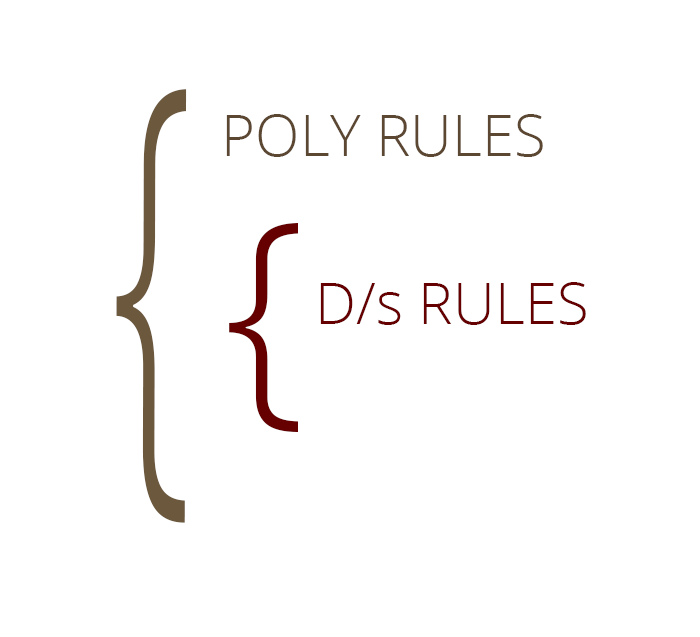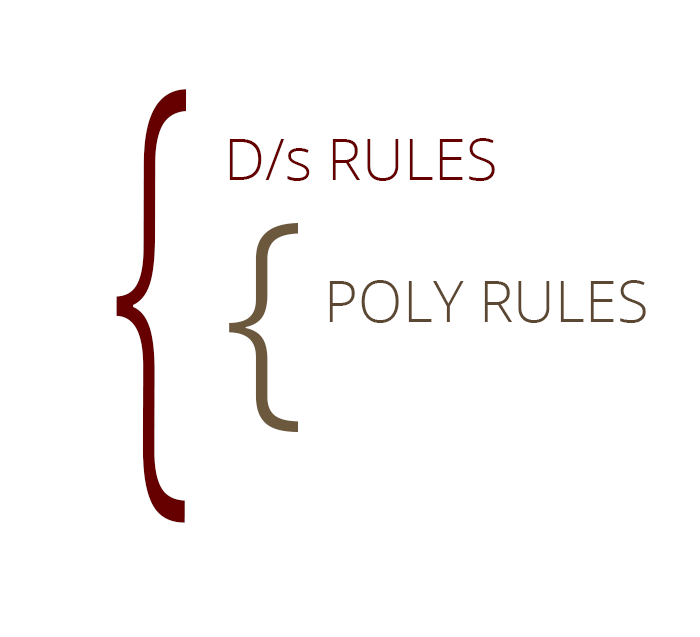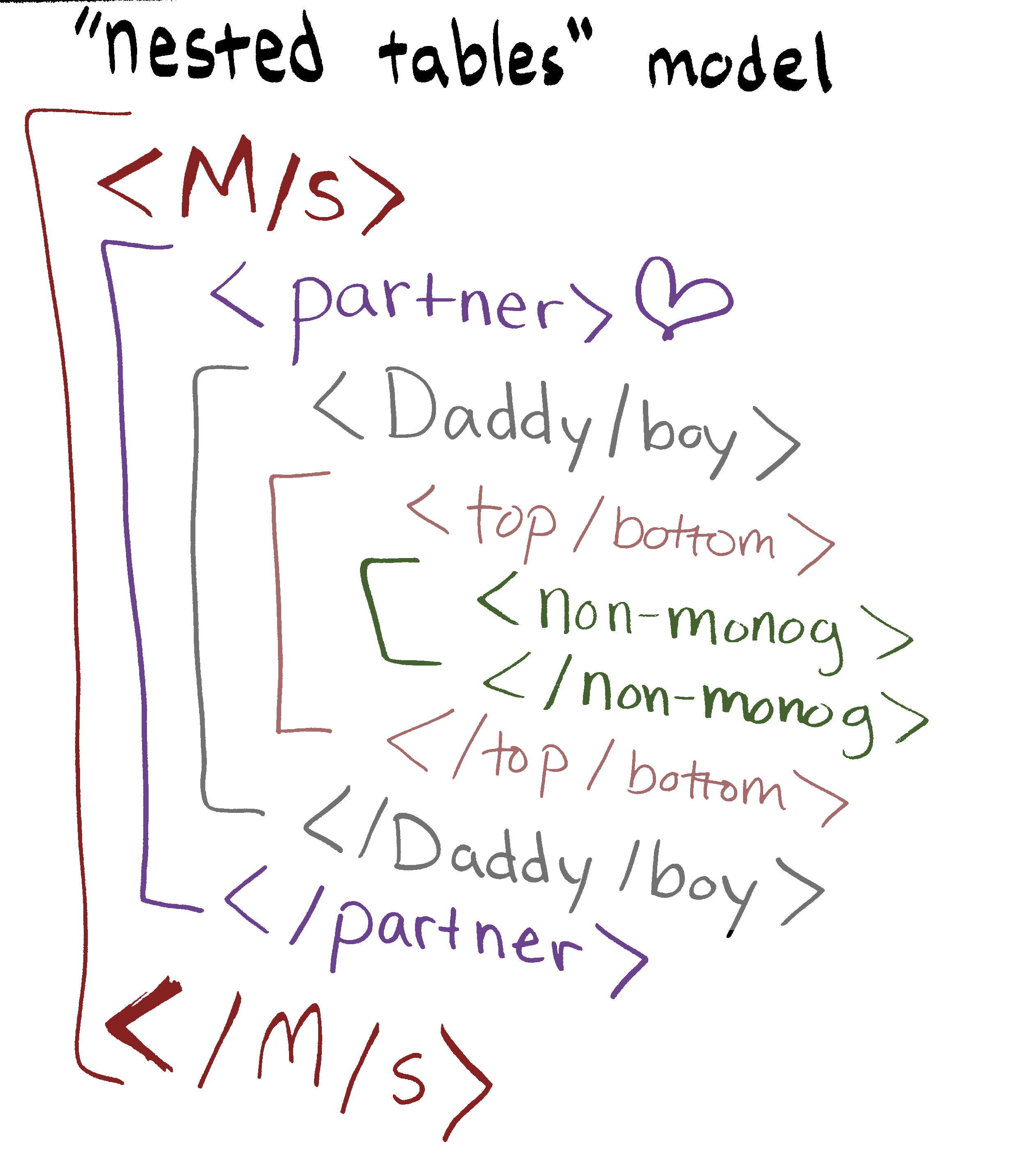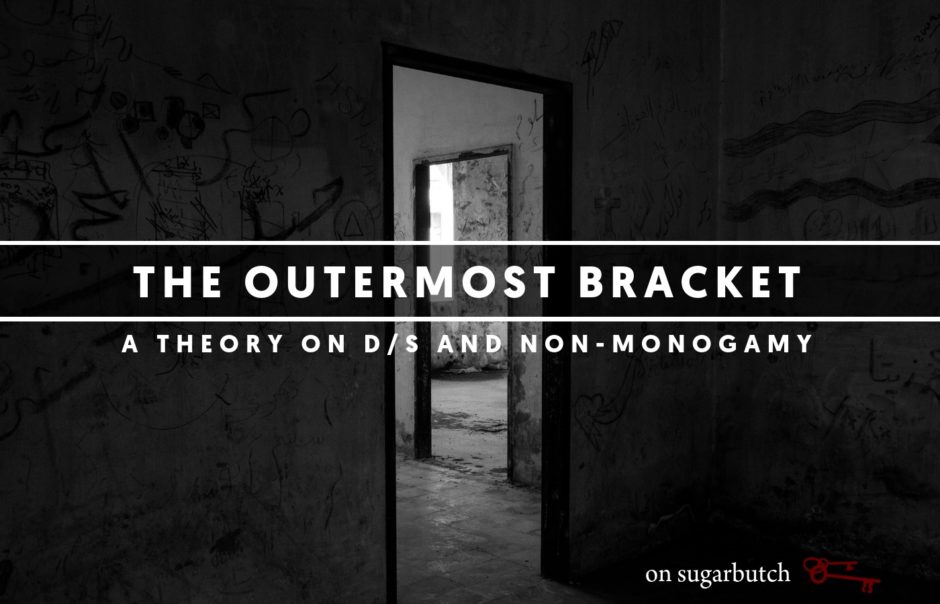Both non-monogamy and power exchange relationships revolve around sets of agreements between the people involved. Sometimes, those agreements are in harmony — and ahhh, isn’t it lovely when that happens? Not just lovely: it is magic.
Sometimes, however, they conflict.
Both D/s and non-monogamous relationships often have agreements (and arguments) which center around control, ownership, and permission. The difference is, non-monogamy often emphasizes the equality of all parties, while D/s is about someone having authority over the other.
As you can imagine, when both D/s and non-monogamy are both happening within one relationship, that can be very difficult to negotiate.
rife and I were both in non-monogamous relationships when we met, and we quickly knew our play — and then our relationship — would have an ongoing authority imbalance (a.k.a. power dynamic, D/s). As our D/s relationship grew, the non-monogamous and D/s agreements became increasingly complicated. Our authority imbalance continued to strengthen, and sometimes it trumped — or we wanted it to trump — our non-monogamous agreements. That didn’t make sense to a lot of our non-monogamous friends or with the polyamoroy theory that we were reading, and we had a lot of trouble navigating that.
In trying to negotiate all of this (with a lot of trial and error and fucking up), we developed a theory we call “the outermost bracket,” that explores which identity is set within the other.
In other words, is the D/s within the non-monogamy agreements, or is the non-monogamy within the D/s agreements?
Quick disclaimer:
This theory doesn’t apply to everyone. If it makes sense in your world, great! Hope you can take it and make it your own and use it to negotiate these complex things with more ease. If it doesn’t apply, cool. Just take what makes sense and leave the rest.
I’m using the terms “D/s”, “dominant/submissive relationship,” “authority imbalance,” and “power dynamic” as somewhat interchangeable. There are dozens of other terms that folks might be using, too, but these are some of the main ones. All of them mean different things to different people with subtle nuance, but for the purposes of this theory, they are similar enough. Generally, I use them to mean all kinds of authority imbalance relationships in and out of the bedroom.
This theory might be most relevant for D/s relationship where the dominant has a lot of control, but some bedroom-only D/s dynamics might apply here, too, since often there are rules executed in the bedroom. Such as: you will only come when I give you permission, you will call me Mistress and nobody else, you will always keep your genitals shaved. As you can imagine, if someone who has those rules is playing with someone else, they might cause conflicts.
Similarly, I’m using the terms “polyam,” “polyamory,” “open relationship,” and “non-monogamy” somewhat interchangeably. We could have long conversations about the nuanced differences between them, and what applies to what, but for the sake of this essay, they’re similar enough.
The conflicts around D/s and non-monogamy are vast and complicated, and, while there might be some parallels and common concepts, the specific circumstances are unique to each polycule or set of folks involved. I don’t assume to speak for everyone or all experiences, and this might not resonate with you at all.

The Key Distinction of the Theory
Is your non-monogamy restricted by your D/s rules and agreements, or is your D/s restricted by your non-monogamy agreements?
Let’s break that down.
When Non-Monogamy is the Outermost Bracket

When non-monogamy is the outermost bracket for someone, a couple’s D/s relationships happen within their open relationship agreements.
This often looks like making relationship guidelines with a partner, or setting one’s own solo-poly or polyamorous family boundaries, and negotiating D/s within the confines of those agreements. Whatever D/s-based rules, protocols, or agreements are made, they do not extend to other partners — and the D/s might be restricted by non-monogamous arrangements.
For Example:
Let’s say that Mel has a partner they live with, Jay, and another partner, Alex, they are in a power exchange relationship with (and perhaps other partners, too).
The relationship with Jay is long-term and they consider themselves primary partners. That relationship has various agreements for how any other relationships happen — how many times per week, whether or not they sleep over, whether they only do certain things with one person and not another. Mel and Jay made these rules together from an egalitarian place, and both adhere to them.
Mel’s relationship with Alex is a power exchange relationship where Mel is the sub and Alex is the dom. Alex wants to exercise some control over Mel’s sexuality — let’s say they want to restrict the use of Mel’s ass so that only they can fuck it. But Jay doesn’t want any restrictions on what they can or can’t do with Mel.
The agreements within the D/s don’t extend to their primary partnership — at least, not without some negotiations between all three of them, and with Jay’s blessings for the restrictions.
(Sometimes, Alex and Jay might get together and conspire to make wonderfully terrible things happen for Mel. But that’s an exception, because non-monogamy is hard and sometimes Alex has lots of feelings and they have to spend lots of time sorting it all out.)
So Jay might have control over very specific things in Mel’s life — for example, what they wear when they get together for dates, or how they keep their hair. Whatever these are, they are not things that interfere with Mel’s other relationships.
But Jay’s control does not extend to whether or not Mel can have any other partners, and does not extend to any parts of their relationship with Alex.
In other words, the rules of the D/s relationship do not extend to the primary relationship, nor to the arrangements of any other non-monogamous activities.
In my experience, this is how the majority of D/s non-monogamous relationships operate.
Having non-monogamy as the outermost bracket can help the D/s boundaries be incredibly clear. Mel might want Alex’s power and control over them to be in certain realms or within certain time restrictions only, and their power dynamic might flourish that way.
When D/s is the Outermost Bracket

When D/s is the outermost bracket for someone, their non-monogamous relationships happen within their D/s agreements.
The dominant in this scenario would be in control — to whatever degree they arrange — of the kind of play the submissive would have with other people.
Let’s use another example:
Carter is Devon’s dominant. Carter is in charge of pretty much every aspect of Devon’s life. Devon occasionally wants to play with other people, but Carter gets to say how that happens, when, and within what context.
That could look like:
- The dominant gives orders when the submissive plays with anyone else
- The dominant is allowed to play with others, but the submissive is not
- The submissive is allowed to do certain things but not other things
- The submissive has to ask permission for any kind of play with others
- The dominant gives permission for all of the sub’s new relationships, but none of their existing ones
Ultimately, the submissive conforms to the dominant’s will, and the arrangements for their non-monogamy are within the confines of the D/s. The submissive’s needs and boundaries are taken into consideration here, and the rules are consented to, but they might be guided by the controlling ideals of D/s and not the egalitarian ideals of open relationships.
This means that the other people Devon is in relationships with must, to some degree, consent to their relationship being underneath the D/s umbrella that Devon has with Carter. Not everyone wants to do that.
How far does the control go?
A dominant controlling the kinds of acts the submissive can or can’t do is one thing; controlling who the submissive is in relationship with is another thing. Vetting or giving permission for a certain relationship to happen or continue can get into tricky territory that can become controlling, unhealthy, or even abusive.
When the dominant controls the kind of non-monogamy that the submissive is allowed to have, it can be a red flag to some folks outside of the relationship. The negotiations of this should be careful and intentional. All parties are in their full agency, give explicit informed consent, and understand that they can talk about it if it becomes a problem between them.
For some folks, it works; for others, it means that the control goes too far.
And this is the key distinction of the Outermost Bracket theory.
Why Does This Matter?
If you know you are into one of these relationship styles more than the other, it can be useful to bring up early on in negotiations. If you can communicate what you’re looking for, you’re much more likely to get it. So, where do you fall? Is non-monogamy your outermost bracket? Is D/s? Or do you structure things in another way?If you’re having trouble figuring it out, I suggest doing a thought experiment: imagine you are in the most ideal D/s relationship. Do you have control over all aspects of your submissive’s relationships? Does your dominant have complete control over you? What would it feel like if they did?
In Conclusion
For me and rife, this distinction was very helpful as we were figuring out how to navigate the theories we knew about non-monogamy and the desires we had within our D/s. We even extended it with geeky HTML references to talk about hierarchies of other relationship identities (for example, our relationship is M/s first, and Daddy/boy within that). More on this later, or come to our “Art of Ownership” class!

There are probably many other theories and best practices within the overlap of D/s and non-monogamy — no doubt this is not the only one! But honestly, there’s not much out there about it. We know of very few resources, aside from Raven Kaldera’s book Power Circuits: Polyamory in a Power Dynamic.





I like this idea. I think it’s certainly underneath a conflict in my previous polycule. My GF had a cohabiting BF and both of us had a D/s relationship with her. He was insecure about my connection with her, and that I am her Mistress. He also felt like his dynamic was lost when the 3 of us spent time together. The explicit agreements between us would have bracketed non-monogamy on the outside and then D/s within. I suspect if we had reversed the brackets, we would have been able to communicate more clearly about rules/expectations and it would have been easier on emotional level. But we didn’t find a good way to talk about the issues – thus this concept is helpful, and doubtless I’ll hark back to it if I find myself in similar places in future.
In my current polycule it’s more fluid than the brackets have space for. Maybe that’s related to switching? There are certainly titles that aren’t shared. There may be future conversations about particular dynamics – especially service – that are not shared. These aspects feel fundamental to both our non monogamy and our kink. So, I’d struggle to bracket those things.
I was wondering about how being a switch, and also relationship anarchist who plays with power and makes commitments changes my experience with this! Our practices sound like what you mention at the bottom Sophia – there might be specific commitments, dynamics, things that aren`t shared but it`s not at so high a level. My brain is racing now trying to think about how I would articulate the theory that describes my dynamics (:
also this theory made me realize that in `polyam` when someone has agreement to ask permission, that this is some power exchange.
Love this! I think OBT applies to a mono/poly coupling as well. Mono could be the outermost bracket or poly could. It really helps me to think about it this way. …
I like the theory. We need more theories about how this all works. But how do you reconcile partnership with M/s at all? Isn’t partnership fundamentally egalitarian? I would be interested in a post about how those two brackets interact.
Seconded!
Thank you so much for sharing this bracket theory! I am also *very* tickled by the HTML model and I’m about to sketch mine out in just a moment, haha.
oh cool, I’d love to see it if you want to share!
I enjoy this relationship geekery. Thanks for sharing with us.
Ooh, this is an interesting one! I also have a relationship where D/s is the outermost bracket, with my non-monogamy restricted by my Dom, and you’re 100% correct in your observation that for folks outside the relationship, this often gets read as a red flag.
The way things work for us is this – my Dom can play with whoever he wants in any capacity, and he doesn’t necessarily have to inform me about it (though he often shares if it was an especially hot experience!). He picks and chooses who he shares me with; there is never any direct contact between me and anyone else outside of the experiences that he facilitates for us; I generally only play with others when he’s present. This is a point that often frustrates people – I don’t get to have my own profile on hookup apps, no one ever gets my phone number or other means of contacting me directly. They deal with him or it doesn’t happen.
Honestly? I love it this way. I’ve had previous relationships where outside partners tried to interfere or cause issues, and this largely eliminates that. I’m also a fat trans man and I can tell you I really appreciate that I don’t have to deal with shitty messages from rude and/or bigoted jerks on the apps! And having my partner present helps to keep me safe too. I’ve had some of the hottest experiences of my life thanks to him, and I wouldn’t change it. If it makes people uncomfortable, they’re not suitable playmates for us.